A Strategy for Grid-Connected PV-Battery System of Mongolian Ger
Abstract
:1. Introduction
2. Description of System
2.1. System Configuration
2.2. Data Collection and Analysis
3. Mathematical Model
3.1. PV and BESS Mathematical Models
3.1.1. Photovoltaic Output Power Model
3.1.2. Battery Energy Storage Model
3.2. Energy Management System Algorithm
4. Problem Formulation
4.1. Grid Electricity Price
4.2. Hybrid System Cost
5. Simulation and Discussion
6. Conclusions
Author Contributions
Funding
Institutional Review Board Statement
Informed Consent Statement
Data Availability Statement
Acknowledgments
Conflicts of Interest
References
- Air Quality Agency. 2021. Available online: http://tsag-agaar.gov.mn/observation/environment-monitoring/air (accessed on 15 December 2021).
- Nakao, M.; Yamauchi, K.; Ishihara, Y.; Omori, H.; Ichinnorov, D.; Solongo, B. Effects of air pollution and seasons on health-related quality of life of Mongolian adults living in Ulaanbaatar: Cross-sectional studies. BMC Public Health 2017, 17, 594. [Google Scholar] [CrossRef] [PubMed] [Green Version]
- Oyunchimeg, C.; Tuya, N.; Zorigt, D.; Sukhbaatar, T.; Bayarkhuu, C. Energy Sector Current Status, Recent Developments and Energy Policies in Mongolia. 2021. Available online: https://nautilus.org/napsnet/napsnet-special-reports/energy-sector-current-status-recent-developments-and-energy-policies-in-mongolia-2/ (accessed on 6 September 2021).
- Adiyabazar, C.; Acosta, M.N.; Gonzalez-Longatt, F.; Rueda, J.L.; Palensky, P. Under-Frequency Load Shedding in Mongolia: Simulation Assessment Considering Inertia Scenarios. In Proceedings of the 2020 IEEE 29th International Symposium on Industrial Electronics (ISIE), Delft, The Netherland, 17–19 June 2020; pp. 1256–1261. [Google Scholar]
- Mongolian Government. Renewable Energy Policy. 2021. Available online: http://https://https://legalinfo.mn/en (accessed on 17 September 2021).
- Alam, M.J.E.; Muttaqi, K.M.; Sutanto, D. Mitigation of Rooftop Solar PV Impacts and Evening Peak Support by Managing Available Capacity of Distributed Energy Storage Systems. IEEE Trans. Power Syst. 2013, 28, 3874–3884. [Google Scholar] [CrossRef] [Green Version]
- Hongbin, W.; Wang, S.; Bo, Z.; Chengzhi, Z. Energy management and control strategy of a grid-connected PV/battery system. Int. Trans. Electr. Energy Syst. 2015, 25, 1590–1602. [Google Scholar]
- Jain, D.; Sandeep, N.; Kumar Verma, A.; Yaragatti, U.R. A Simple Methodology for Sizing of Stand-Alone PV-Battery System. In Proceedings of the 2019 8th International Conference on Power Systems (ICPS), Jaipur, India, 20–22 December 2019; pp. 1–5. [Google Scholar] [CrossRef]
- Li, J. Optimal sizing of grid-connected photovoltaic battery systems for residential houses in Australia. Renew. Energy 2019, 136, 1245–1254. [Google Scholar] [CrossRef]
- Zou, B.; Peng, J.; Li, S.; Li, Y.; Yan, J.; Yang, H. Comparative study of the dynamic programming-based and rule-based operation strategies for grid-connected PV-battery systems of office buildings. Appl. Energy 2022, 305, 117875. [Google Scholar] [CrossRef]
- Guidara, I.; Tina, G.M.; Souissi, A.; Chaabene, M. Techno-economic adequacy for PV-Battery sizing of a residential grid-connected installation. In Proceedings of the 2020 11th International Renewable Energy Congress (IREC), Hammamet, Tunisia, 29–31 October 2020; pp. 1–5. [Google Scholar] [CrossRef]
- Yoza, A.; Yona, A.; Senjyu, T.; Funabashi, T. Optimal capacity and expansion planning methodology of PV and battery in smart house. Renew. Energy 2014, 69, 25–33. [Google Scholar] [CrossRef]
- Bouakkaz, A.; Mena, A.J.G.; Haddad, S.; Ferrari, M.L. Efficient energy scheduling considering cost reduction and energy saving in hybrid energy system with energy storage. J. Energy Storage 2021, 33, 101887. [Google Scholar] [CrossRef]
- Zhang, Y.; Lundblad, A.; Campana, P.E.; Benavente, F.; Yan, J. Battery sizing and rule-based operation of grid-connected photovoltaic-battery system: A case study in Sweden. Energy Convers. Manag. 2017, 133, 249–263. [Google Scholar] [CrossRef]
- Munkhtur, Z.; Bat-Orshikh, B.; Bat-Orgil, T.; Dugarjav, B. Technical Evaluation of Utility-Interactive Photovoltaic Power Generation System with Energy Storage based on the Experimental Setup. In Proceedings of the 2019 IEEE Transportation Electrification Conference and Expo, Asia-Pacific (ITEC Asia-Pacific), Seogwipo, Korea, 8–10 May 2019; pp. 1–5. [Google Scholar] [CrossRef]
- Battuvshin, B.; Turmandakh, B.; Park, J.H.; Bayasgalan, D. The Study on Development of PV-ES hybrid system for Mongolian Household. Trans. Korean Inst. Electr. Eng. 2017, 66, 1905–1912. [Google Scholar]
- Saez-de Ibarra, A.; Martinez-Laserna, E.; Koch-Ciobotaru, C.; Rodriguez, P.; Stroe, D.I.; Swierczynski, M. Second life battery energy storage system for residential demand response service. In Proceedings of the 2015 IEEE International Conference on Industrial Technology (ICIT), Seville, Spain, 17–19 March 2015; pp. 2941–2948. [Google Scholar] [CrossRef]
- Zorig Foundation and Konrad Adenauer Stiftung. Statistical Information of Air Pollution. 2021. Available online: https://www.kas.de/de/web/mongolei (accessed on 19 October 2021).
- Arab, A.H.; Taghezouit, B.; Abdeladim, K.; Semaoui, S.; Razagui, A.; Gherbi, A.; Boulahchiche, S.; Mahammed, I.H. Maximum power output performance modeling of solar photovoltaic modules. Energy Rep. 2020, 6, 680–686. [Google Scholar] [CrossRef]
- Wahyuddin, M.I.; Priambodo, P.S.; Sudibyo, H. State of charge (SOC) analysis and modeling battery discharging parameters. In Proceedings of the 2018 4th International Conference on Science and Technology (ICST), Yogyakarta, Indonesia, 7–8 August 2018; pp. 1–5. [Google Scholar]
- Homan, B.; Marnix, V.; Hurink, J.L.; Smit, G.J. A realistic model for battery state of charge prediction in energy management simulation tools. Energy 2019, 171, 205–217. [Google Scholar] [CrossRef]
- Energy Regulation Commission of Mongolia. Electricity Tariff. 2021. Available online: http://https://erc.gov.mn/web/en/ (accessed on 25 November 2021).
- Khoury, J.; Mbayed, R.; Salloum, G.; Monmasson, E. Comparison of the water heating technique’s impact on the sizing of a standalone PV-battery backup system assisting an intermittent primary energy source. In Proceedings of the IECON 2015—41st Annual Conference of the IEEE Industrial Electronics Society, Yokohama, Japan, 9–12 November 2015; pp. 857–862. [Google Scholar] [CrossRef]
- Dinh, H.T.; Kim, D. An Optimal Energy-Saving Home Energy Management Supporting User Comfort and Electricity Selling With Different Prices. IEEE Access 2021, 9, 9235–9249. [Google Scholar] [CrossRef]
- Rahmani-andebili, M.; Shen, H. Cooperative distributed energy scheduling for smart homes applying stochastic model predictive control. In Proceedings of the 2017 IEEE International Conference on Communications (ICC), Paris, France, 21–25 May 2017; pp. 1–6. [Google Scholar] [CrossRef]
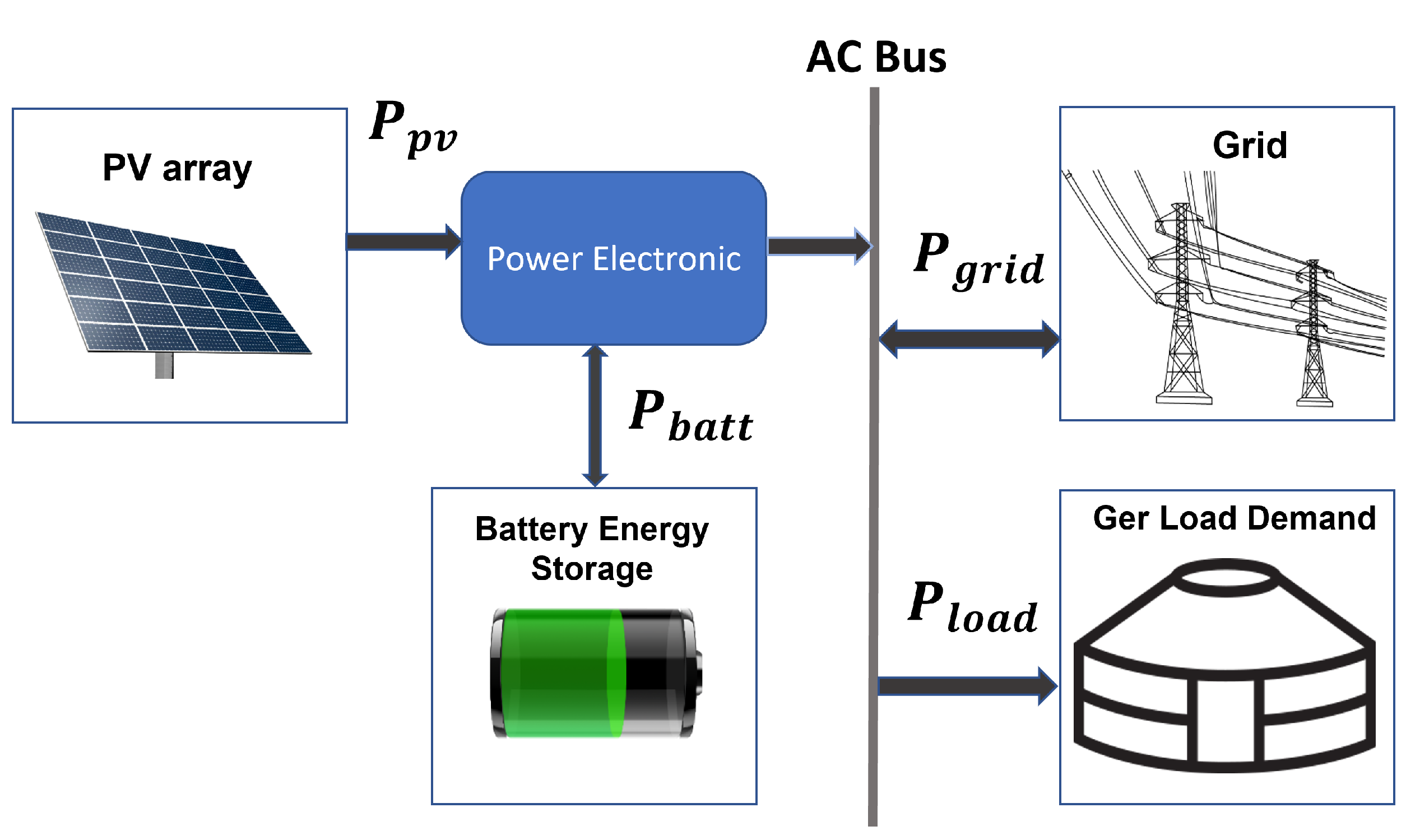

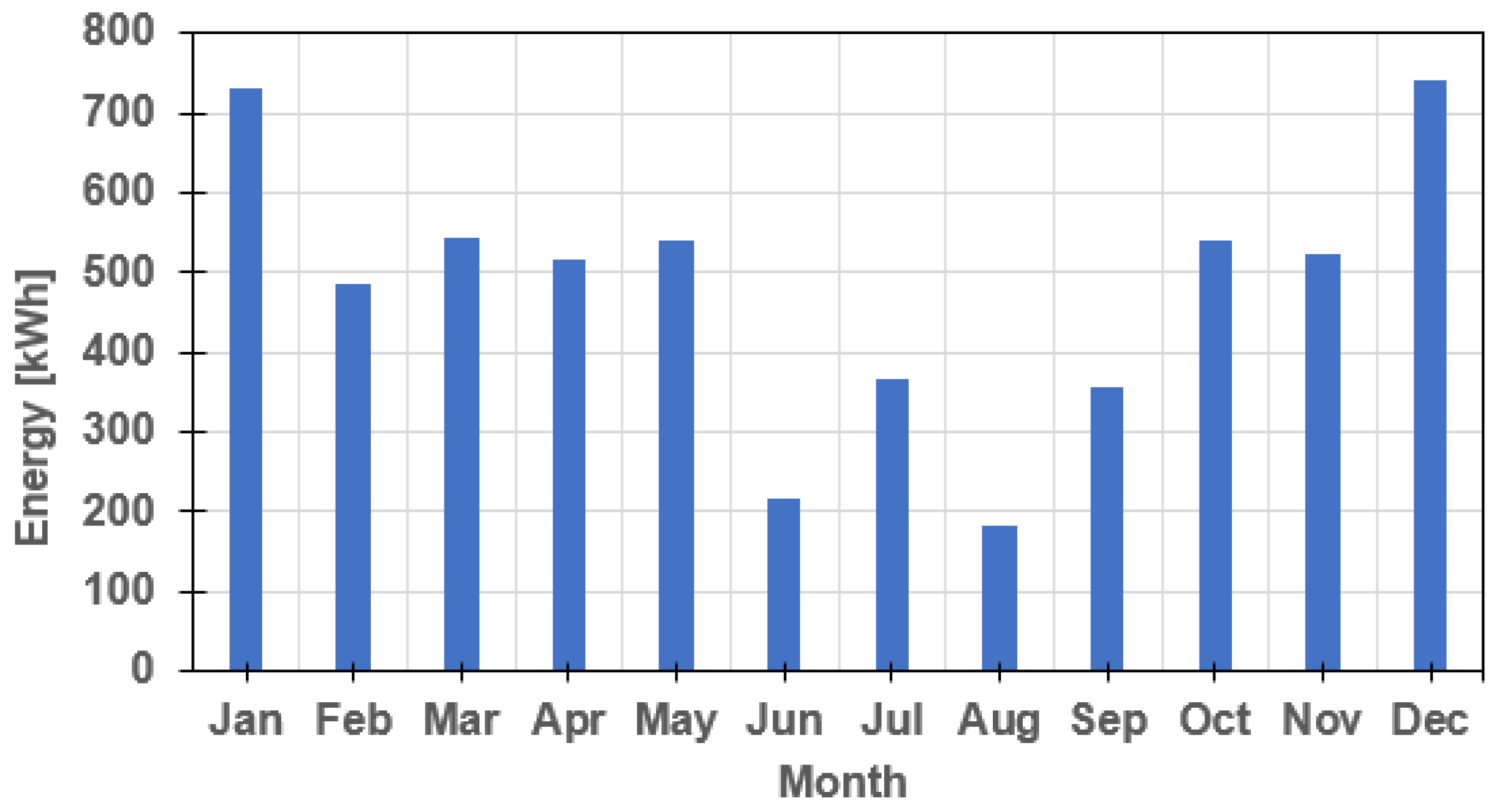



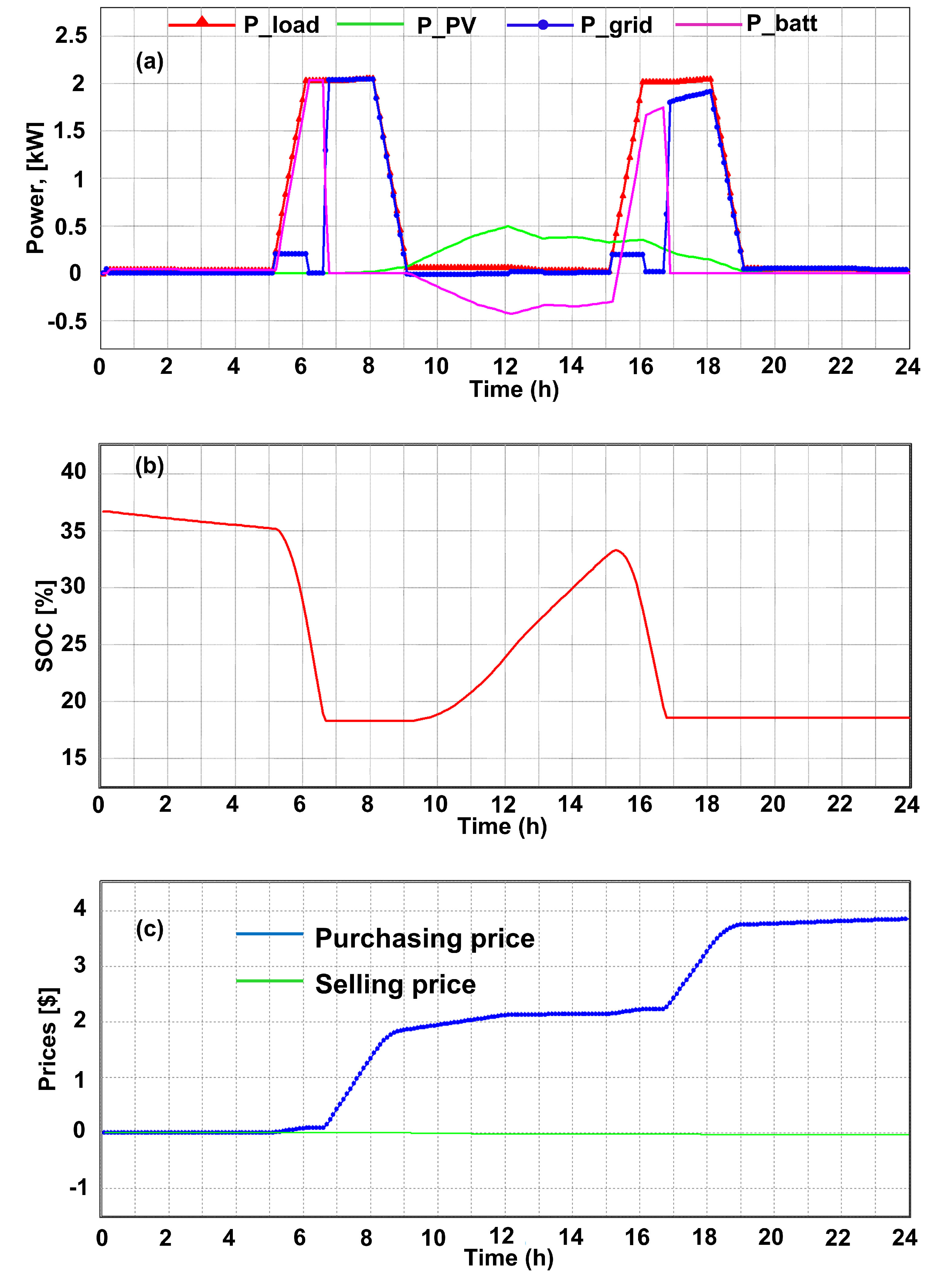

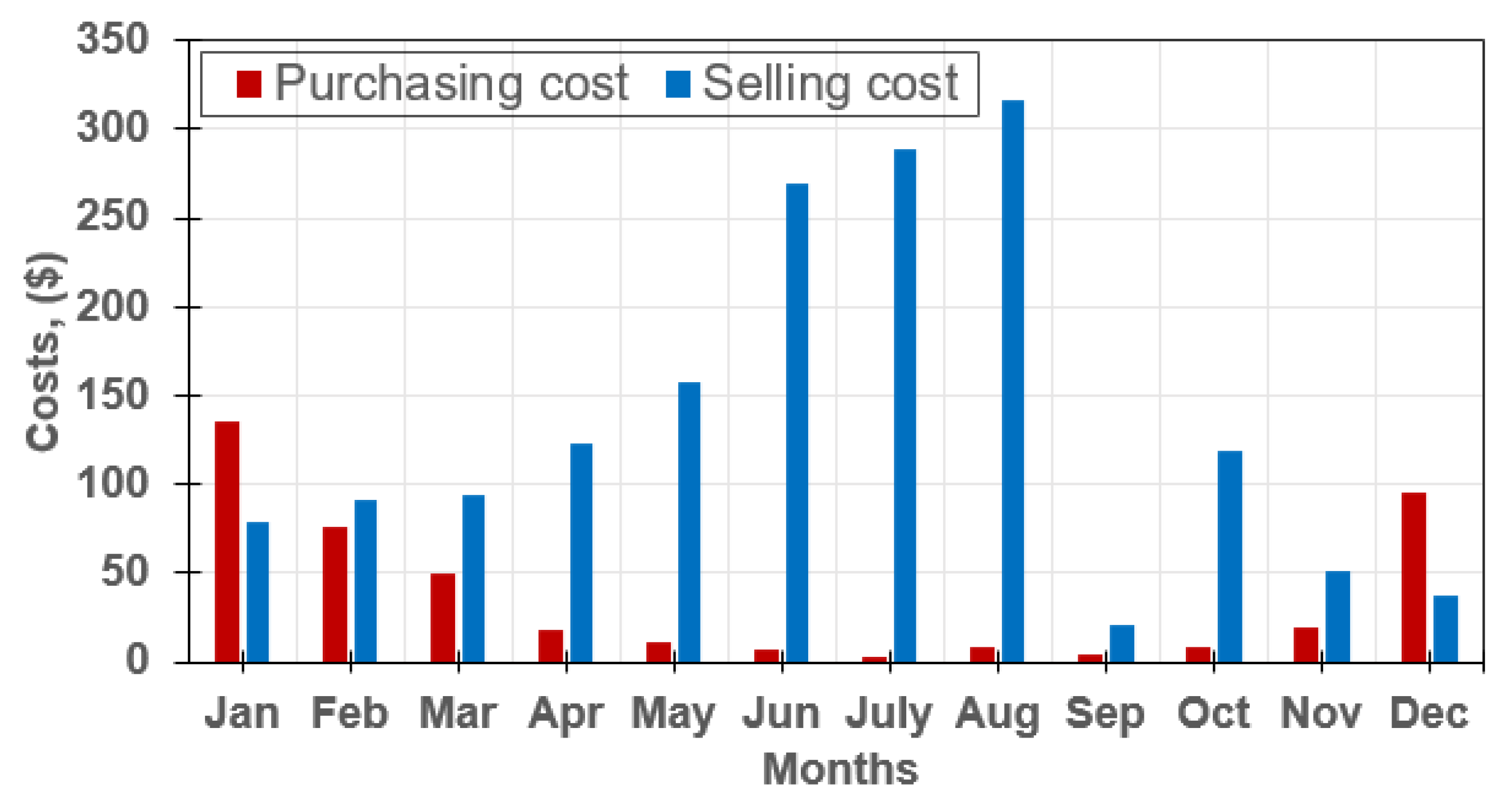
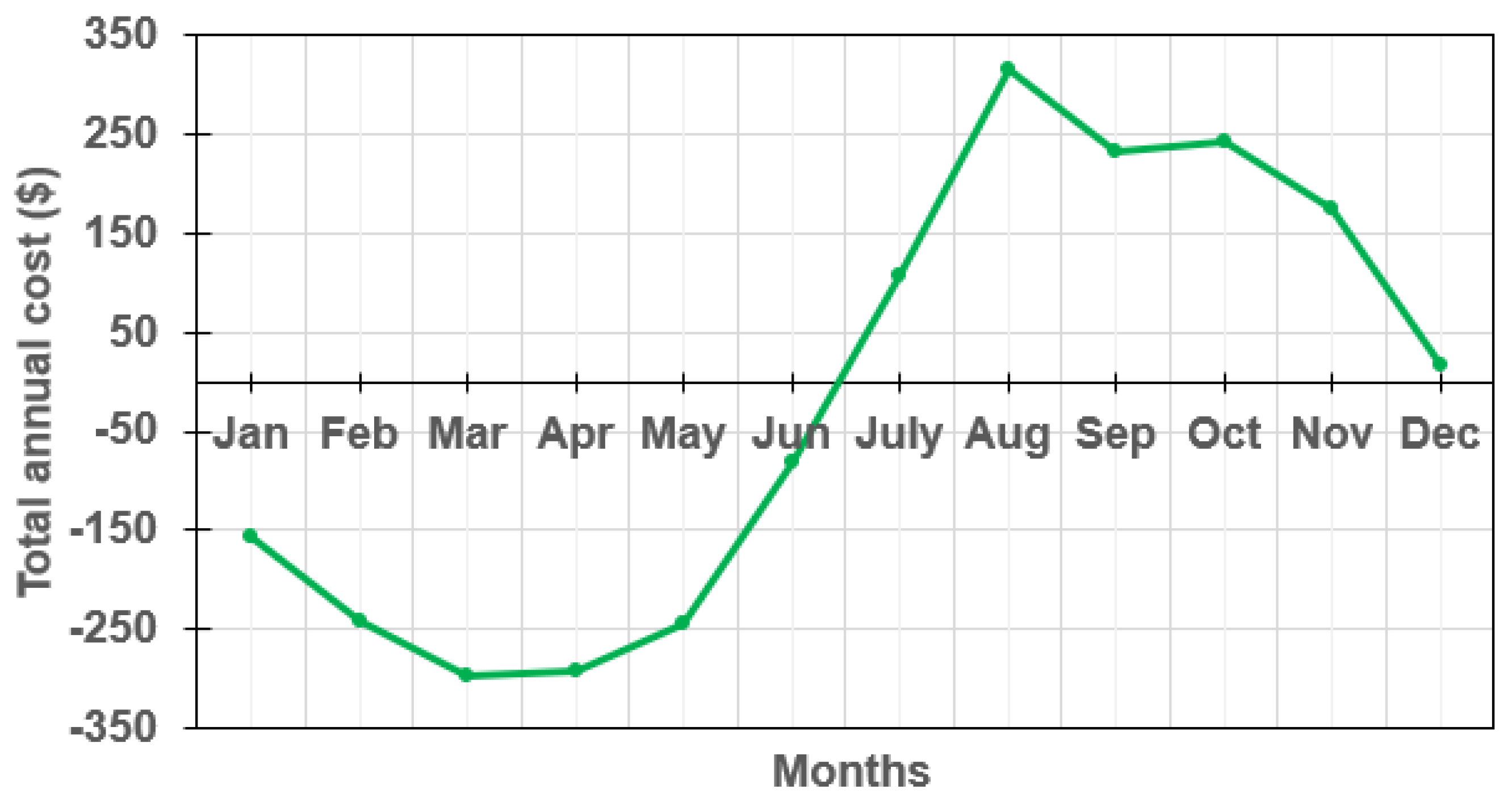
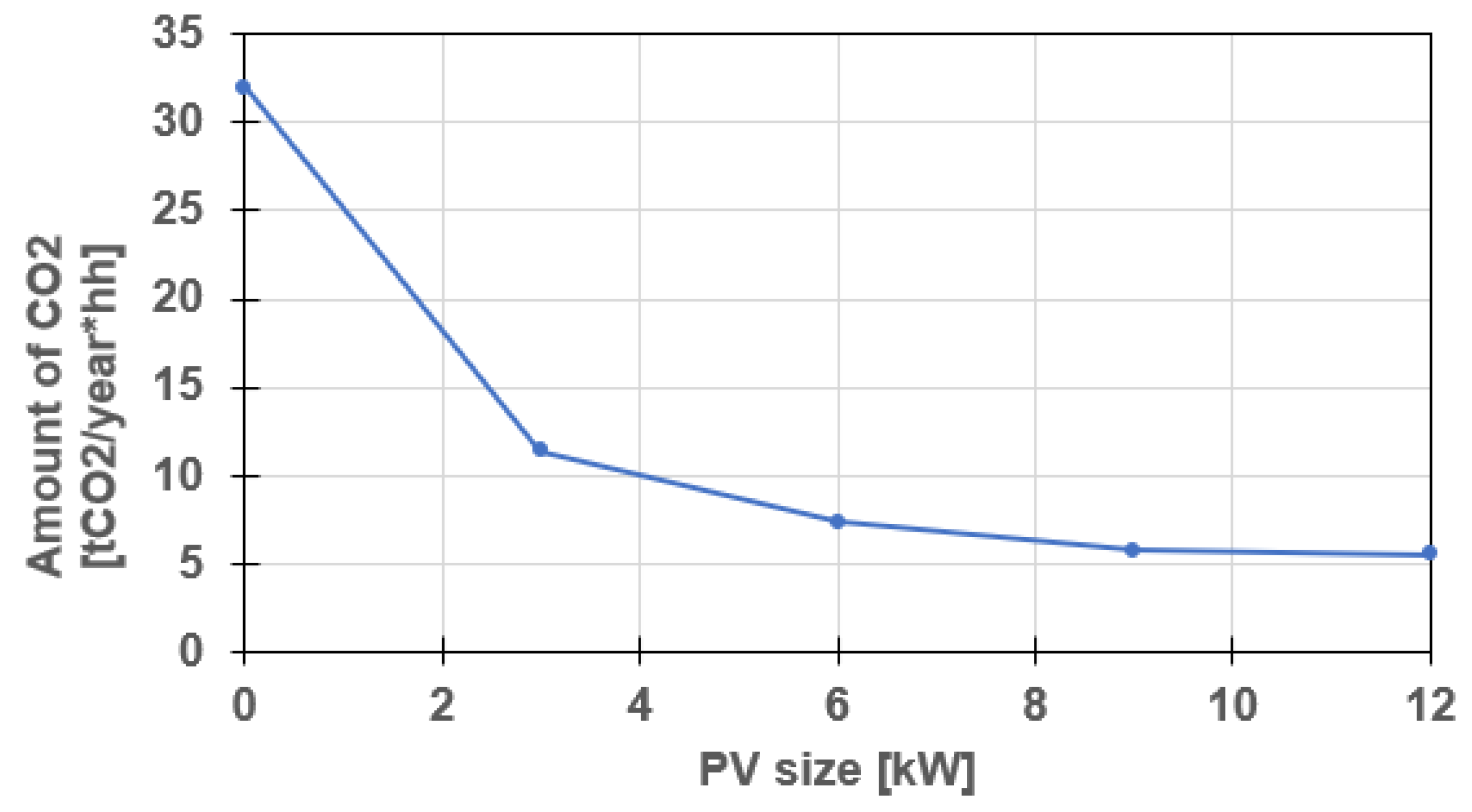
| Component | Specs. | Capital Cost ($) |
|---|---|---|
| PV panels | 6000 W | 9600 |
| Battery ES | 12 kWh | |
| Inverter | 6000 W | |
| Electric heater | 2000 W |
Publisher’s Note: MDPI stays neutral with regard to jurisdictional claims in published maps and institutional affiliations. |
© 2022 by the authors. Licensee MDPI, Basel, Switzerland. This article is an open access article distributed under the terms and conditions of the Creative Commons Attribution (CC BY) license (https://creativecommons.org/licenses/by/4.0/).
Share and Cite
Erdenebat, B.; Urasaki, N.; Byambaa, S. A Strategy for Grid-Connected PV-Battery System of Mongolian Ger. Energies 2022, 15, 1892. https://doi.org/10.3390/en15051892
Erdenebat B, Urasaki N, Byambaa S. A Strategy for Grid-Connected PV-Battery System of Mongolian Ger. Energies. 2022; 15(5):1892. https://doi.org/10.3390/en15051892
Chicago/Turabian StyleErdenebat, Baigali, Naomitsu Urasaki, and Sergelen Byambaa. 2022. "A Strategy for Grid-Connected PV-Battery System of Mongolian Ger" Energies 15, no. 5: 1892. https://doi.org/10.3390/en15051892
APA StyleErdenebat, B., Urasaki, N., & Byambaa, S. (2022). A Strategy for Grid-Connected PV-Battery System of Mongolian Ger. Energies, 15(5), 1892. https://doi.org/10.3390/en15051892






